
By Nick Routledge
A highlight of my gardening year arrives in Spring among the nursery benches on the first occasion I rub the leaves of a Tagetes sp. between my finger and thumb and raise the rich, swoon-inducing scent to my nose. Zowee! What a surprise! The promise of sunsplashed summer!
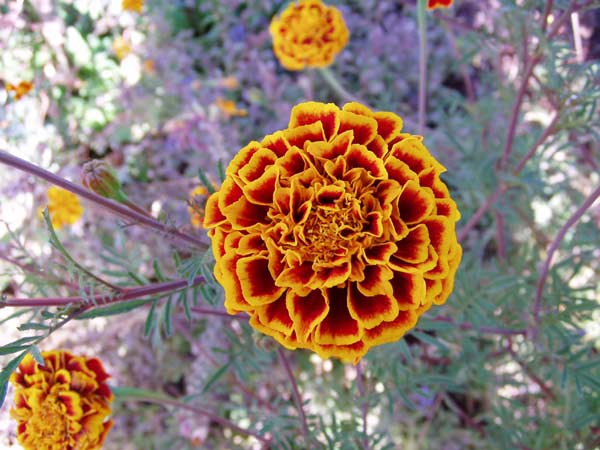
1. T. patula. Sparkler or Pax Botanica
I'm passionate about Tagetes, or "marigolds" as they are commonly named in the USA. Admittedly, it's not the dimunitive 6" high border plant I care for but, rather, the varieties up to 5' high and 4' wide I have largely sourced directly and indirectly from the garden of Peace Seeds' Dr. Alan Kaupler, the master plant breeder and former research director for Seeds of Change who has bred and selected these plants into the magnificent characters they are today. The photographs here represent seed that Andrew and Sarah are carrying, a partial selection from my collection.
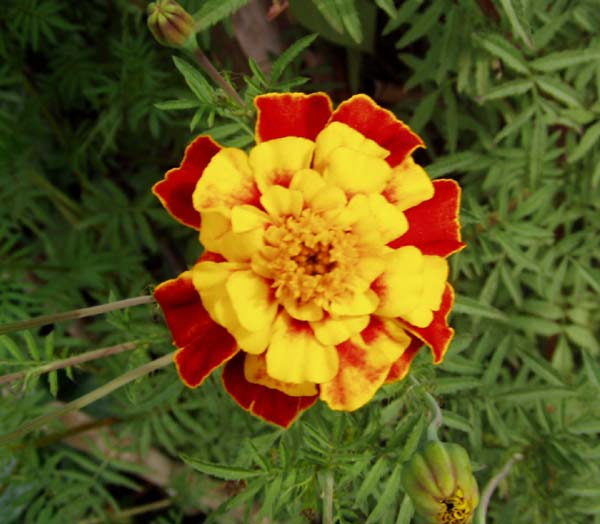
2. T. patula. Sufi Sam
From my experience, this is an extremely vigorous genus. I typically grow about 15 accessions each year of Tagetes patula, T. erecta and T. tenuifolia. In recent times, I have focused most of my attention on T. patula. The intense colors of a vast profusion of 2" flowers showing striking variety in petal structure and color - mostly a broad spectrum of yellows and burgundies, on large plants typically between 3' - 5' high have won them a defining presence in my summer gardens.
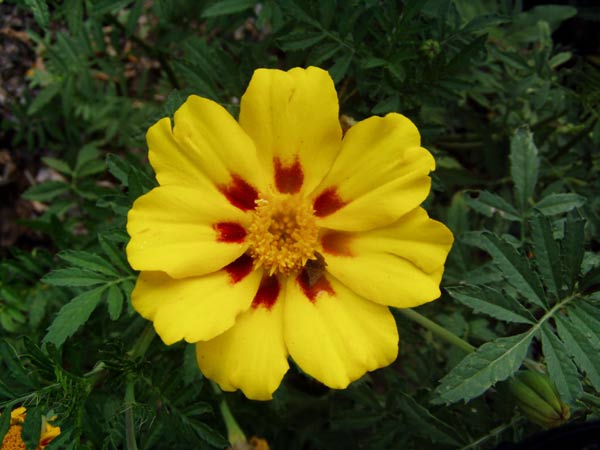
2. T. patula. Exquisite
These annuals just keep pumping out an astonishing profusion of flowers all the way from mid-summer through to the late Fall when they finally succumb to the frost and heavy rains of our Pacific-Northwestern winters. For some weeks they are the only summer flower still remaining in the garden that hasn't succumbed to the cold and rot. It is quite delightful to come in from the cold of winter's onset clutching handfuls of marigolds. The stems are strong and the plants hold well in a vase. Inside an unheated greenhouse, the plants will hold until a hard frost.
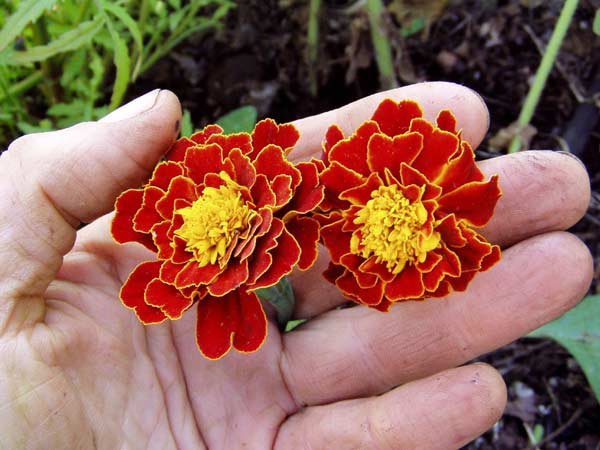
3. T. patula. Al-Hallaj
They are very forgiving plants. Not at all fussy. Very easy to grow. In full sun, with space, and water, they get large, sizing up before they begin exploding with color. These varieties range in size and habit but generally have a bushy, upright habit from 3'-5' high and 3'-4' wide.
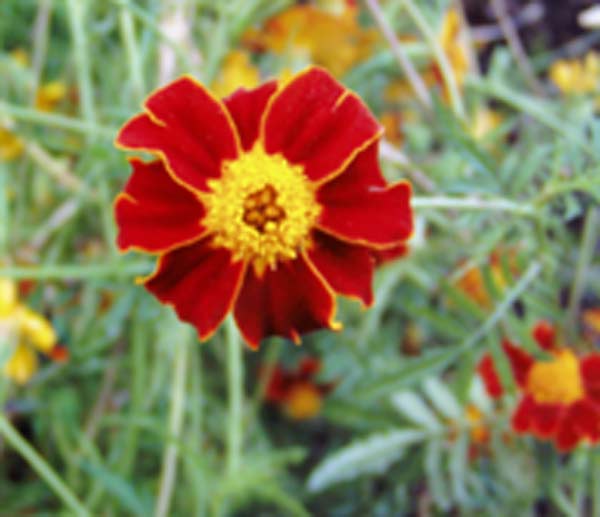
4. T. patula. Burgundy Roundel
Planted in a row, they make a spectacular summer hedge. In semi-shade they will tend to get long and lean and produce far fewer flowers. (In rich soil, with imbalanced light, they will tend to flop.) They are surprisingly drought-tolerant. We have a 3-month Mediterranean drought here, during our summer months. Without much in the way of water, they will still put on an impressive display, though the plants are smaller and sparser, adopting an attractive, rangy, airier habit with fewer flowers on longer, branching stems. Completely starved of water, the plants and flowers will be smaller, making exquisite, proportioned cut flowers for 4" high bouquets.
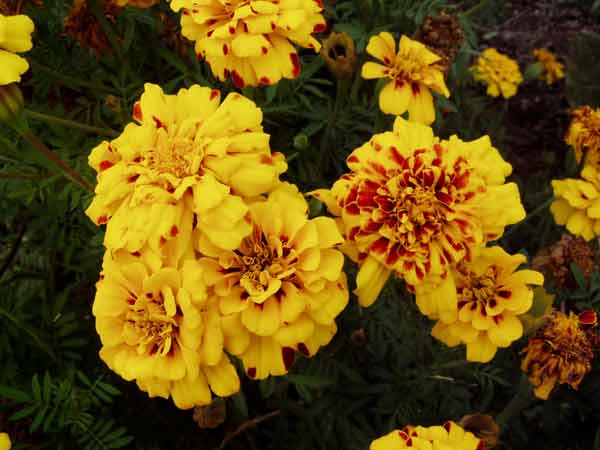
5. T. patula. Yellowredfleck
The plants' habit and their fetching balance of boldness and delicacy make them perfect for placing at the side of paths or an entranceway where their presence often attracts comment and touch. Color patterns differ markedly from flower to flower on the same plant. This tendency is compounded by the species' tendency to change color with the changing temperatures of the season. As the weather cools, the burgundies come to the fore. This is especially noticeable in the highly distinctive Pinwheel and Anastasia whose striking color delineations evolve noticeably with each passing week.
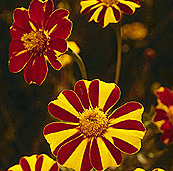
6.
T. patula. Appears in Curtis's Garden Manual 1790, and is called
variously Striped Marvel or Pinwheel. I call it Pinwheel Metamorph
Marigolds are some of the easiest flowers to save seed from. The seedheads mature quickly and over a long season, drying down on the plant. At a push, they can still be harvested after the rains have arrived. Harvesting seed is as easy as picking a seedhead off the plant between thumb and forefinger, as wowing! visitors to my garden often do. The seeds separate themselves easily. When planting marigold seed, hold the seed lengthwise between thumb and forefinger and gently squeeze. If it folds, discard it. If it's firm plant it. The plants can be started 4-6 weeks before last frost date in a greenhouse, although these are plants that do not need to be pushed. They seem highly disease-resistant. They are very forgiving in both greenhouse and garden. Their striking and unique character lends a delightful and distinctive texture to a nursery table.
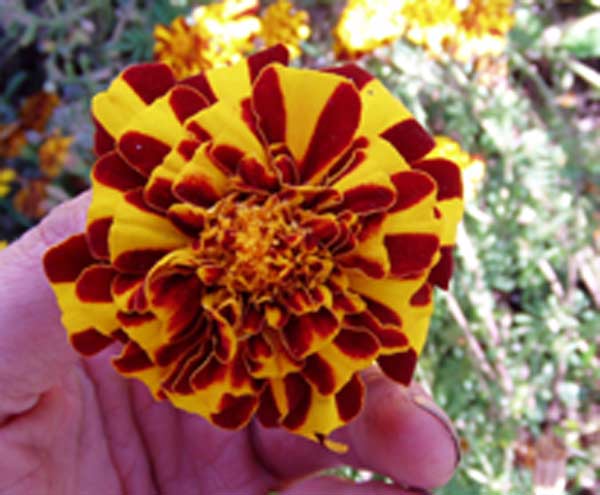
7. T. patula. Anastasia
I also grow T. erecta, although I have included only one accession from a wide variety I carry, in the stash that Andrew and Sarah are carrying. It's my recent favorite. T. erecta are also profuse bloomers, and this accession particularly so. The bright, intensely orange 3" flowers are held up on a plant with a ("V-shaped") ascending habit, with thick, branching stems holding up a long-running floral display.
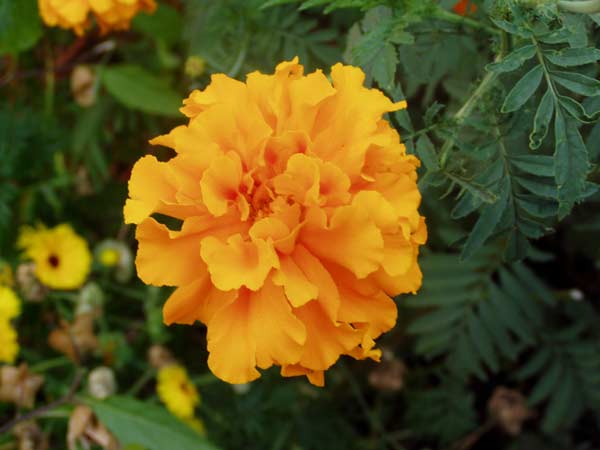
8. T. erecta. Savannah Rain
Again, the plant sizes up before flowering - a little later in the season that T. patula and as with T. patula it then flowers prolifically and without letting up until the wintry weather of late Fall finally slows it. The sheer weight of the flowers will tend to snap some of the side branches at the stem in late summer winds, unless the plant is sheltered or supported. The snapped-off stems, if placed in a large vase, will hold for around 3 weeks before the flowers wilt.
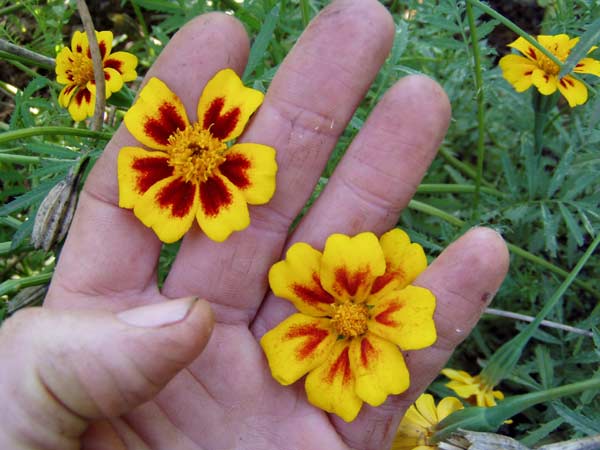
9. T. patula. Sweetheart
These Tagetes are robust and beautiful beings. They have immense democratic appeal. Their forgiving nature, the length of their flowering season, the astonishing profusion and intensity of their floral display, their size and habit, and the ease with which they are grown, add up to a rather unique variety of traits that make them, I believe, one of the more significant horticultural contributions to the cause of Beauty to have emerged Stateside in recent years. For a hint at the sensibility informing the breeding and selection process which has made thse plants what they are today, please check out the photo essay of the Seed Ambassadors' Visit to Dr. Alan Kapuler's in the weeks prior to the European adventure.
I am keen to learn more about Tagetes, its botany and mythology. Likewise, I am very interested in new accessions to trial. Please contact me with goodies.
Last updated, February 15, 2007